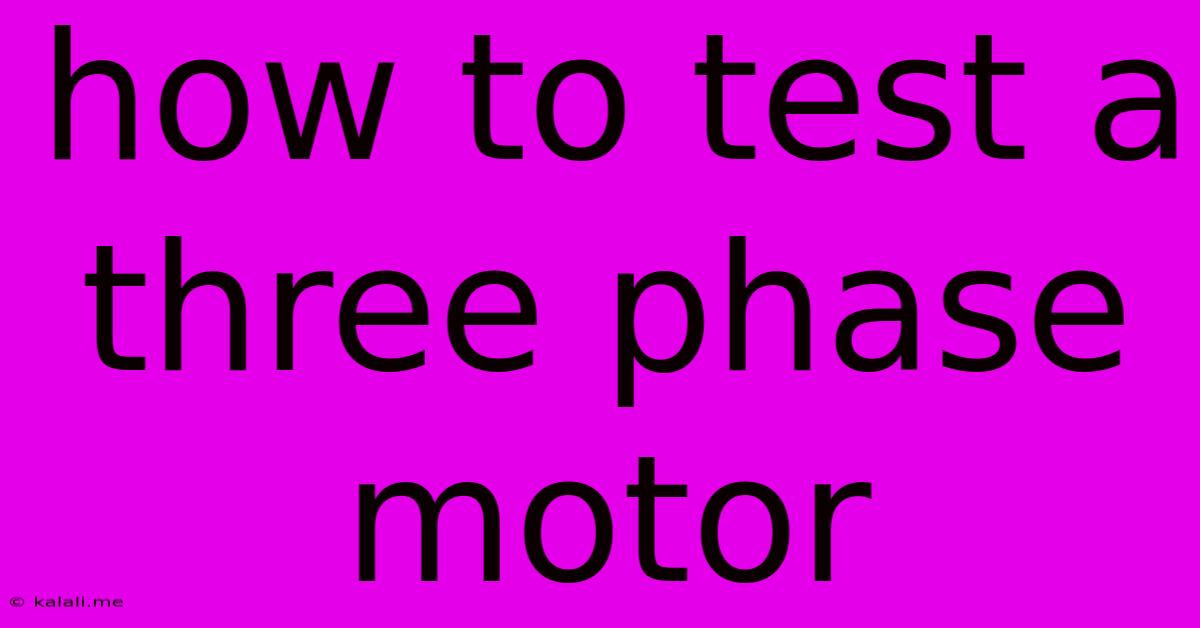How To Test A Three Phase Motor
Kalali
Jun 09, 2025 · 4 min read

Table of Contents
How to Test a Three-Phase Motor: A Comprehensive Guide
Meta Description: Learn how to effectively test a three-phase motor using simple methods and readily available tools. This guide covers insulation resistance tests, winding resistance checks, and motor performance evaluations, helping you diagnose common problems and ensure safe operation.
Troubleshooting a three-phase motor can be challenging, but with the right approach, you can accurately diagnose problems and avoid costly repairs or replacements. This comprehensive guide details several methods for testing a three-phase motor, from simple resistance checks to more advanced performance evaluations. We'll cover the necessary safety precautions, tools, and step-by-step instructions to help you confidently assess the health of your motor.
Safety First: Essential Precautions Before Testing
Before you begin any testing, prioritize safety. Three-phase motors operate at high voltages and currents, posing significant electrical hazards. Always disconnect the motor from its power supply and lock out/tag out the circuit breaker to prevent accidental energization. Furthermore:
- Use appropriate Personal Protective Equipment (PPE): This includes insulated gloves, safety glasses, and non-conductive footwear.
- Discharge any residual capacitance: Large motors can retain a charge even after disconnection. Use an appropriate discharge tool to safely release any stored energy.
- Work in a well-ventilated area: Testing may involve generating heat or sparks.
- Never work alone: Have a colleague nearby in case of an emergency.
Basic Tests: Winding Resistance and Insulation Resistance
These tests provide a preliminary assessment of the motor's windings. They require a multimeter capable of measuring both resistance (Ohms) and insulation resistance (Megohms).
1. Winding Resistance Test
This test checks for shorts or open circuits in the motor windings.
- Procedure: Set your multimeter to the resistance (Ohms) range. Measure the resistance between each pair of motor leads (U-V, V-W, W-U). The readings should be similar for each pair.
- Interpretation: Significant differences in resistance readings between pairs suggest a short or open circuit in one or more windings. An extremely high reading indicates an open circuit, while a very low reading indicates a short circuit. Consult the motor's nameplate for expected resistance values as a benchmark.
2. Insulation Resistance Test (Megger Test)
This test assesses the insulation integrity of the windings. It requires a megger, a specialized instrument that applies a high voltage to measure insulation resistance.
- Procedure: Use a megger to measure the insulation resistance between each winding and the motor's ground. Also, measure the insulation resistance between winding pairs.
- Interpretation: Low insulation resistance indicates degradation or damage to the motor's insulation, potentially leading to short circuits or ground faults. The acceptable insulation resistance value varies depending on the motor's voltage and size; consult the manufacturer's specifications or relevant electrical codes.
Advanced Tests: Motor Performance Evaluation
These tests require specialized equipment and expertise. They are crucial for identifying more complex issues affecting motor performance.
1. No-Load Test
This test evaluates the motor's performance under no-load conditions, providing insights into its efficiency and mechanical losses. It typically involves measuring the current and power consumption of the motor while running without a load.
2. Locked Rotor Test
This test measures the motor's starting current and torque. It involves applying power to the motor while its shaft is held stationary. This test requires careful attention to safety as the starting current can be extremely high.
3. Load Test
This test involves running the motor under its normal operating load. It allows for the assessment of the motor's performance under real-world conditions, identifying any efficiency or performance issues.
Analyzing the Results and Taking Action
Once you've completed the tests, carefully analyze the results. Compare your readings with the manufacturer's specifications or industry standards. Significant deviations could indicate a problem requiring professional attention. Some common issues identified through these tests include:
- Winding faults: Shorts, opens, or grounds in the windings.
- Bearing problems: Excessive noise or vibration during operation.
- Insulation breakdown: Reduced insulation resistance.
- Rotor issues: Unbalanced rotor, rotor bar damage.
Remember, this guide provides a general overview. For accurate diagnosis and repair of complex motor problems, consult a qualified electrician or motor repair specialist. They possess the expertise and equipment needed to effectively troubleshoot and repair three-phase motors safely and efficiently.
Latest Posts
Latest Posts
-
Can You Buy A Fighter Jet
Jun 09, 2025
-
Are Legendaries Shiny Locked In Black And White
Jun 09, 2025
-
What Is It Called When Someone Wont Leave You Alone
Jun 09, 2025
-
How To Calculate Voltage Drop Across Resistor
Jun 09, 2025
-
Fireplace Pilot Light Wont Stay Lit
Jun 09, 2025
Related Post
Thank you for visiting our website which covers about How To Test A Three Phase Motor . We hope the information provided has been useful to you. Feel free to contact us if you have any questions or need further assistance. See you next time and don't miss to bookmark.